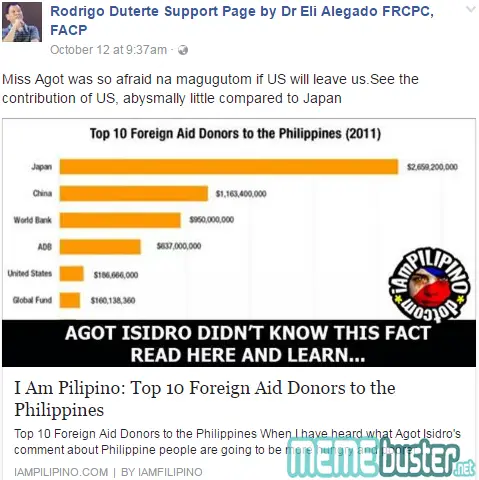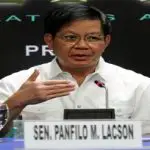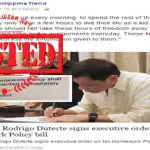A chart enumerating the top 10 foreign aid donors to the Philippines has been circulating on Facebook and widely shared by fan pages.
One of these pages, Showbiz Government, even taunted actress Agot Isidro for her post criticizing President Rodrigo Duterte’s dare for the US and the EU to withdraw their aid to the country. Its caption said: “China and Japan has given us more than the US, AUS & EU combined! Ayan magugutom si Agot kapag nawala ang US!!!”

Another Facebook fan page for Duterte shared an article showing the same chart, with the caption that said: “Miss Agot was so afraid na magugutom if US will leave us. See the contribution of US, abysmally little compared to Japan.”

Even former interior secretary Rafael Alunan III during FVR’s administration shared the same article, with this caption: “FYI. Empirical evidence that speaks for itself. The top 2 foreign donors are Japan at No. 1 and China at No. 2, followed by the World Bank and the ADB. The US is a distant fifth.”

However, Facebook user Bernard Ong presented facts refuting the implications behind the Facebook posts above – that the US was not that much of a generous donor anyway and that the Chinese donated more than the Americans.
In his post, Ong said he wrote this post to counter the memes circulating online based on the November 2011 article, “Top 10 Foreign Aid Donors to the Philippines,” written by Pete Troilo on Devex. The biggest donor was Japan ($2.659 billion), followed by China ($1.163 billion), World Bank ($950 million), Asian Development Bank ($637 million), and US ($187 million).
Troilo also enumerated projects under the China-PH agreements, such as the Northrail Project, Main Line South Railway Project, and the Non-Intrusive Container Inspection system and each project’s worth.
However, Ong went on to clear things up by referring to NEDA’s Official Development Assistance (ODA) data in 2015.
First Point: “Big Donor is not the same as Big Lender”
He said that being a big donor does not mean being a big lender because donating and lending are two different things in ODA.
“ODA has 2 components – concessional loans & outright grants. Loans must be repaid. Grants are free,” Ong said.
Ong then compared the figures of the grants portfolio in 2011 with the figures in 2015.
“2011 ODA grants portfolio: #1 USA $841m. #2 Australia $270m. #3 EU $197m. #4 UN $182m #5 World Bank 168m. #6 Japan $135m. #7 Germany $89m,” he wrote.
“In 2015 ODA grants portfolio: #1 USA $1.149b. #2 UN $608m. #3 Australia $589m. #4 EU $175m. #5 Japan $167m #12 China $5.7m,” he added.
Ong emphasized that the US donated 200 times more than China did.
Second Point: “China is Big Lender. Timing makes it seem Bigger”
Ong summed up the ODA loans portfolio during in 2011 and 2015 as well.
“2011 ODA loans portfolio: #1 Japan/JICA $2.738b. #2 World Bank $2.4b. #3 Others $1.32b. #4 China $1.141b #5 ADB $922m. Among China’s loans $900m or 79% is allocated to NorthRail Project,” Ong said.
“2015 ODA loans portfolio: #1 World Bank $4.453b. #2 Japan $3.159b. #3 ADB $2.231b #4. South Korea 525m. #5 France $437m. #6 China $115m,” he added.
If you look at 2011, China did lend the Philippines 13.3% of its ODA loans. However, the figure drastically changed in 2015, wherein China only lent 1.03% of the Philippines’ ODA loans.
[ads1]
Third Point: “USA is Bigger Lender, Adjusting for Aid Channels”
The US helps the Philippines through various channels.
Ong enumerated those channels as the following: “World Bank for development lending (ODA) loans. International Finance Corp for investment. International Monetary Fund for financial stabilization, USAID for grants (ODA grants), military donations.”
When it comes to World Bank, the US certainly had more shares than China, owning 17.47% of the financial institution, compared to China’s 4.85% share.
Ong also noted how in 2015, ODA loans granted by the US amounted to $778 million, which is more than double China’s $331 million loans, after incorporating the participation of World Bank in the equation.
Fourth Point: “Big Chinese Projects Did Not Happen”
Those Chinese projects enumerated by Troilo in his article did not materialize.
“NorthRail Project got bogged down on issues of rights of way, informal settlers & corruption. Then President Aquino called the Chinese loan “neither concessional nor helpful to our country.” China demanded early repayment for the first $400m with interest. The other $500m was never released,” he said.
As opposed to the Devex article, Ong said that Main Line South Railway project was no even the Chinese’s project. In fact, it did not even make it to the 2011 NEDA ODA portfolio. The Main Line project then combined efforts with North-South Rail Project, which would cost P171 billion, the biggest among all the PPP projects.
“This has not bid out yet – 5 years after it was listed as China-funded project,” Ong said.
Fifth Point: “China’s Loans Carry Conditions”
As per the law, concessional loans come with a “concessional” element, which is loans being priced below market rates, as per Ong’s explanation.
“Concessional loans are required by law to carry a “concessional” element – they must be priced below market rates. Concessionality is defined as reduction on repayments, expressed at present value using 10% discount rate,” Ong wrote.
“That 10% discount rate assumption is too high. In 2015, Philippine government was able to borrow $2b from open market at 3.95%. It is misleading to count the reductions vs excessive 10% rate as “concession” when we can secure similar value by borrowing at cheap rates form the market,” he further explained.
Ong said that while the Philippines was able to borrow $900 million for the NorthRail loan from China Eximbank, the bank only approved of the loan because the China National Machinery and Industry Corp. (Sinomach) won in the bidding.
“It is conditional on the use of a Chinese suppler. Such exclusive-supplier arrangements are often suspected of overpricing and kickback arrangements,” Ong noted.
For those who might be wondering where Ong is getting his facts he also provided links to his sources.
Ong urged his followers to help others understand this issue better, especially since the chart used was back in 2011. So many things have happened in the past five years since then. Moreover, if donation is what’s in question here, Memebuster posted an article before about former National Security Adviser Roilo Golez’s commentary on the “Yolanda” aid coming from the US, EU, and other countries. The US gave 10.5% of the total Yolanda aid, while both Russia and China donated less than one percent of the total funds. Golez said that he presented the facts to show who the Philippines’ real friends are and who did not care as much when tragedy devastated and killed thousands of Filipinos.
As Ong has pointed out, the US still helped the Philippines so much more than China did. The 2015 data are hugely different from the 2011 data, which was also before the PH-China relations soured due to the dispute over the West Philippine Sea.
Sources: (facebook.com, devex.com)
[ads3]


